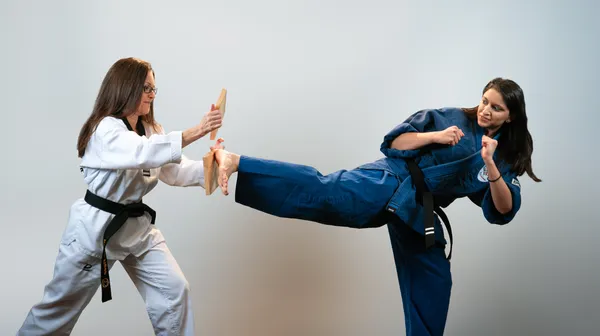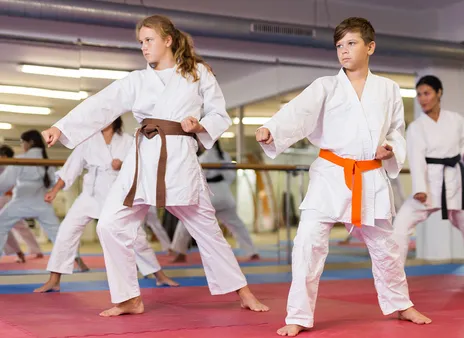Table of Contents
Martial arts is renowned for its disciplinary and physical benefits. But like any sport, injuries can occur. At Kizworld, we believe in proactive care. We're bringing you a comprehensive guide to "The most common martial arts injuries and how to treat them." Discover the prevalent injuries, their treatments, and preventive measures to ensure a safe and rewarding martial arts journey.
The Most Common Martial Arts Injuries and How to Treat Them
I. Common Martial Arts Injuries: Prevention and Treatment
Common Martial Arts Injuries: Prevention and Treatment
Martial arts, with its intense physical training and high-impact techniques, carries a risk of injuries. Being aware of these potential injuries is crucial for a safe and enjoyable training experience. This guide sheds light on the most common martial arts injuries, their treatments, and effective prevention strategies. Whether you're a seasoned martial artist or just starting out, understanding these injury risks can help you stay safe while reaping the many benefits of this rewarding discipline.
Common Hand, Wrist Injuries and Treatments
The hands and wrists are particularly vulnerable to injuries in martial arts due to repeated strikes and grappling techniques. Common hand and wrist injuries include:
- Sprains and strains: Overstretching or tearing of ligaments or tendons can cause sprains and strains. Symptoms include pain, swelling, and difficulty moving the affected joint.
- Fractures: Broken bones in the hand or wrist can result from direct impact or twisting forces. Symptoms include severe pain, deformity, and difficulty using the affected limb.
- Carpal tunnel syndrome: This condition arises from pressure on the median nerve in the wrist, causing numbness, tingling, and pain in the hand and fingers.
Treatment for hand and wrist injuries typically involves rest, ice, compression, and elevation (RICE), followed by physical therapy and rehabilitation exercises. In severe cases, surgery may be necessary.
To prevent hand and wrist injuries, it's essential to warm up properly before training, use appropriate hand protection gear, and maintain good technique during strikes and grappling.
Read more about the most common gymnastics injuries and how to prevent them.
Head and Neck Injuries in Martial Arts
The head and neck are also susceptible to injuries in martial arts, especially during sparring or competition. Common head and neck injuries include:
- Concussions: A concussion is a brain injury caused by a blow to the head. Symptoms can range from headache and dizziness to loss of consciousness.
- Neck strains and sprains: Overstretching or tearing of neck muscles or ligaments can lead to neck strains and sprains. Symptoms include pain, stiffness, and difficulty moving the neck.
- Eye injuries: Eye injuries, such as corneal abrasions or retinal detachment, can occur from direct strikes or accidental contact with fingers or elbows.
Treatment for head and neck injuries depends on the severity of the injury. Concussions typically require rest and monitoring, while neck strains and sprains may benefit from physical therapy. Eye injuries may require specialized treatment by an ophthalmologist.
To prevent head and neck injuries, it's crucial to wear appropriate headgear during training and competition, maintain good posture and technique, and avoid reckless or overly aggressive behavior.
Read more about the most common surfing injuries and how to avoid them.
Avoiding a Groin Injury
The groin area is another common site of injury in martial arts, particularly in grappling disciplines. Groin injuries can be caused by sudden or forceful movements, such as kicks or takedowns.
- Groin strains: Overstretching or tearing of groin muscles can lead to groin strains. Symptoms include pain, swelling, and difficulty moving the affected leg.
- Testicular injuries: Direct blows to the testicles can cause severe pain and swelling. In severe cases, testicular torsion (twisting of the testicle) may occur, requiring immediate medical attention.
Treatment for groin injuries typically involves rest, ice, compression, and elevation (RICE), followed by physical therapy and rehabilitation exercises. In some cases, surgery may be necessary.
To prevent groin injuries, it's essential to warm up properly before training, wear protective gear such as a groin guard, and maintain good technique during grappling and striking.
Read more about the most common calisthenics mistakes and how to fix them.
Knees, Hips, Ankles, Feet Injuries in Martial Arts
The lower extremities are also prone to injuries in martial arts due to the high-impact nature of many techniques. Common knee, hip, ankle, and foot injuries include:
- Knee injuries: Knee injuries, such as anterior cruciate ligament (ACL) tears and meniscus tears, can occur during sudden changes in direction or landing from jumps. Symptoms include pain, swelling, and difficulty bending or straightening the knee.
- Hip injuries: Hip injuries, such as hip flexor strains and labral tears, can result from repetitive kicking or grappling techniques. Symptoms include pain, stiffness, and difficulty moving the hip.
- Ankle injuries: Ankle injuries, such as sprains and fractures, can occur from rolling or twisting the ankle during footwork or grappling. Symptoms include pain, swelling, and difficulty walking.
- Foot injuries: Foot injuries, such as plantar fasciitis and stress fractures, can arise from repetitive impact or improper footwear. Symptoms include pain, swelling, and difficulty walking.
Treatment for lower extremity injuries typically involves rest, ice, compression, and elevation (RICE), followed by physical therapy and rehabilitation exercises. In severe cases, surgery may be necessary.
To prevent lower extremity injuries, it's essential to warm up properly before training, wear appropriate footwear, maintain good technique during strikes and grappling, and avoid overtraining.
Read more about the most common parkour injuries and how to prevent them.
Risks of Practicing Martial Arts Barefoot
While practicing martial arts barefoot may provide a more natural feel and better grip, it also increases the risk of certain injuries. These include:
- Cuts and abrasions: Bare feet are more susceptible to cuts and abrasions from mats, equipment, or rough surfaces.
- Fungal infections: Walking barefoot in damp or unsanitary environments can increase the risk of fungal infections, such as athlete's foot.
- Plantar fasciitis: Practicing martial arts barefoot can put excessive strain on the plantar fascia, a thick band of tissue that runs along the bottom of the foot, leading to plantar fasciitis.
To minimize the risks associated with practicing martial arts barefoot, it's essential to keep feet clean and dry, wear appropriate footwear when necessary, and avoid training in unsanitary environments.
Read more about the most common snowboarding injuries and how to avoid them.
Prevention is Better than Cure
Preventing martial arts injuries is crucial for a safe and enjoyable training experience. Here are some general tips for injury prevention:
- Warm up properly: Warming up before training helps prepare the body for physical activity and reduces the risk of injuries.
- Use appropriate protective gear: Wearing protective gear, such as headgear, mouthguards, and groin guards, can help minimize the risk of injuries.
- Maintain good technique: Proper technique is essential for preventing injuries. Work with a qualified instructor to learn and practice correct techniques.
- Avoid overtraining: Overtraining can lead to fatigue and increase the risk of injuries. Listen to your body and take rest days when needed.
- Stay hydrated: Staying hydrated helps maintain optimal physical performance and reduces the risk of injuries.
By following these prevention strategies and being mindful of potential injuries, martial artists can train safely and reap the many benefits of this rewarding discipline.
Read more about the most common running injuries and how to prevent them.
II. Frequently Occurring Injuries in Martial Arts
Frequently Occurring Injuries in Martial Arts
Martial arts involve dynamic and rigorous training, which can unfortunately lead to various injuries. Common martial arts injuries include hand and wrist injuries like sprains, fractures, and tendonitis; head and neck injuries such as concussions, bruises, and whiplash; and groin injuries comprising strains, tears, and hernias.
Additionally, knees, hips, ankles, and feet are susceptible to sprains, strains, and fractures due to high-impact techniques. These injuries can be potentially severe, and it is crucial to take precautions to minimize the risk of occurrence. Let's del delve into each type of injury and explore effective prevention strategies.
Hand, Wrist Injuries, and Treatments
- Strains and Sprains: Overstretching or tearing of muscles or ligaments can result in strains and sprains. Symptoms typically include pain, swelling, and limited mobility.
- Tendonitis: Inflammation of the tendons, which connect muscles to bones, can cause pain, tenderness, and stiffness.
- Fractures: Breaks in bones can occur due to high-impact strikes or falls.
Treatment options may involve rest, ice, compression, and elevation (RICE), physical therapy, and in severe cases, surgery.
Head and Neck Injuries and Treatments
- Concussions: A head injury that disrupts normal brain function, usually caused by a sudden impact. Symptoms include headache, nausea, vomiting, and confusion.
- Bruises: Bleeding beneath the skin's surface due to trauma, often causing discoloration and pain.
- Whiplash: A neck injury caused by sudden forceful movement, resulting in pain, stiffness, and headaches.
Treatment for head and neck injuries may include rest, ice, pain medication, and physical therapy. In severe cases, surgery may be necessary.
Prevention is Better than Cure
While injuries can happen in martial arts, there are steps you can take to reduce the risk:
- Proper Warm-Up: Always start your training with a thorough warm-up to prepare your body for the intense movements.
- Appropriate Technique: Ensure you are taught and practicing the correct techniques under the guidance of a qualified instructor.
- Gradual Progression: Avoid pushing yourself too hard too quickly. Gradually increase the intensity and duration of your training.
- Protective Gear: Use appropriate protective gear, such as hand wraps, headgear, and mouth guards, to minimize the risk of injuries.
- Listen to Your Body: Pay attention to your body's signals. If you experience pain or discomfort, stop the activity and rest.
- Conditioning: Engage in regular strength training and flexibility exercises to improve your overall physical fitness and reduce the likelihood of injuries.
By following these preventive measures, you can significantly decrease the chances of sustaining injuries while enjoying the benefits of martial arts training.
III. Preventive Measures to Minimize Injury Risk in Martial Arts
Preventive Measures to Minimize Injury Risk in Martial Arts
Martial arts training can be physically demanding, and injuries can occur even with the best precautions. However, there are several steps you can take to minimize your risk of injury, including:
- Warm up properly: Warming up your muscles before training helps to prepare them for the demands of martial arts and reduce the risk of strains and sprains.
- Stretch regularly: Stretching your muscles regularly helps to improve flexibility and range of motion, which can help to prevent injuries.
- Use proper technique: Learning and practicing proper technique is essential for avoiding injuries. This includes using the correct stances, strikes, and blocks, and avoiding overexertion.
- Listen to your body: If you feel pain, stop training and rest. Pushing yourself too hard can lead to injuries.
- Stay hydrated: Drinking plenty of water helps to keep your muscles hydrated and functioning properly, which can help to prevent injuries.
- Wear protective gear: Wearing protective gear, such as a mouthguard, headgear, and gloves, can help to protect you from injuries.
- Train with a qualified instructor: Training with a qualified instructor who can teach you proper technique and supervise your training can help to reduce your risk of injury.
By following these tips, you can help to minimize your risk of injury and enjoy the benefits of martial arts training.
In addition to the general preventive measures listed above, there are some specific things you can do to avoid common martial arts injuries, such as:
- Hand and wrist injuries: To avoid hand and wrist injuries, make sure to use proper technique when striking and blocking. Also, avoid overtraining and give your hands and wrists time to rest.
- Head and neck injuries: To avoid head and neck injuries, wear headgear during training and sparring. Also, be aware of your surroundings and avoid striking or being struck in the head or neck.
- Groin injuries: To avoid groin injuries, wear a groin protector during training and sparring. Also, be careful when performing kicks and other techniques that could put stress on the groin.
- Knees, hips, ankles, and feet injuries: To avoid knee, hip, ankle, and foot injuries, make sure to warm up properly and stretch regularly. Also, use proper technique when performing kicks and other techniques that could put stress on these joints.
By following these tips, you can help to minimize your risk of injury and enjoy the benefits of martial arts training.
If you do experience an injury, it is important to seek medical attention as soon as possible. Early treatment can help to prevent further injury and speed up the healing process.
Martial arts can be a great way to get in shape, learn self-defense, and improve your overall health and well-being. By following these preventive measures, you can help to minimize your risk of injury and enjoy the benefits of martial arts training.
Related posts:
- The Most Common Gymnastics Injuries and How to Prevent Them
- The Most Common Surfing Injuries and How to Avoid Them
- The Most Common Calisthenics Mistakes and How to Fix Them
- The Most Common Parkour Injuries and How to Prevent Them
- The Most Common Snowboarding Injuries and How to Avoid Them
- The Most Common Running Injuries and How to Prevent Them
- The Most Common Kickboxing Injuries and How to Avoid Them
- The Most Common Boxing Injuries and How to Prevent Them
- The Most Common Skateboarding Injuries and How to Avoid Them
IV. Effective Treatment Strategies for Common Martial Arts Injuries
Effective Treatment Strategies for Common Martial Arts Injuries
RICE Protocol
- Rest: Give the injured area time to heal by avoiding activities that aggravate the injury.
- Ice: Apply ice to the injured area for 20 minutes at a time, several times a day, to reduce swelling and pain.
- Compression: Use an elastic bandage to wrap the injured area, which can help to reduce swelling and provide support.
- Elevation: Keep the injured area elevated above the level of your heart to help reduce swelling.
Over-the-Counter Pain Relievers
Over-the-counter pain relievers, such as ibuprofen or acetaminophen, can help to reduce pain and inflammation. Be sure to follow the directions on the package and do not take more than the recommended dosage.
Physical Therapy
Physical therapy can help to improve range of motion, strength, and flexibility in the injured area. A physical therapist can also teach you exercises to help prevent future injuries.
Surgery
In some cases, surgery may be necessary to repair a severe injury. Surgery is typically only recommended if other treatments have not been successful.
Preventing Martial Arts Injuries
There are a number of things you can do to help prevent martial arts injuries, including:
- Warm up before each workout.
- Stretch regularly.
- Use proper technique when performing martial arts techniques.
- Listen to your body and stop if you feel pain.
- Wear protective gear, such as a helmet, mouthguard, and gloves.
By following these tips, you can help to reduce your risk of injury and enjoy the benefits of martial arts for years to come.
The Most Common Gymnastics Injuries and How to Prevent Them
V. Conclusion
Martial arts training can be a highly rewarding and transformative experience, but it's important to be aware of the potential risks of injuries. By understanding the most common martial arts injuries, their treatments, and most importantly, how to prevent them, martial artists can significantly reduce their chances of experiencing these setbacks. Always remember to listen to your body, train safely, and consult with experienced instructors and medical professionals when necessary. With the right precautions and a focus on prevention, you can minimize the risks and enjoy the many benefits that martial arts has to offer.